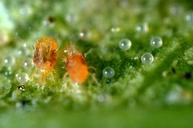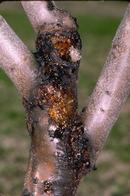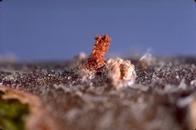
Spider mites
Identification tip: The overwintering female mites are red or orange colored and are found under rough almond
bark, in ground litter, and on winter weeds. Adult males are not present in the winter. |

American plum borer
Identification tip: Extensive gumming around scaffold crotches, at pruning wounds, or in crown galls may
indicate the presence of this borer. |

Peach twig borer hibernacula
Identification tip: Overwintering larvae are sheltered in tiny cells (hibernacula) that they bore under
the bark of limb crotches on 1- to 4-year-old wood or in bark cracks on larger limbs and the trunk. |


